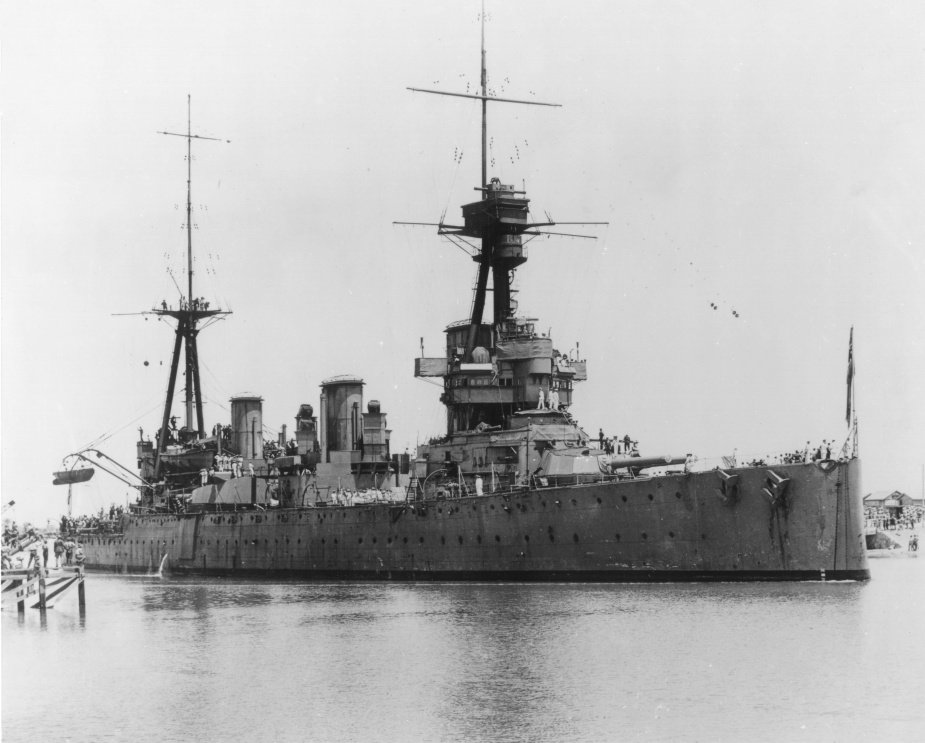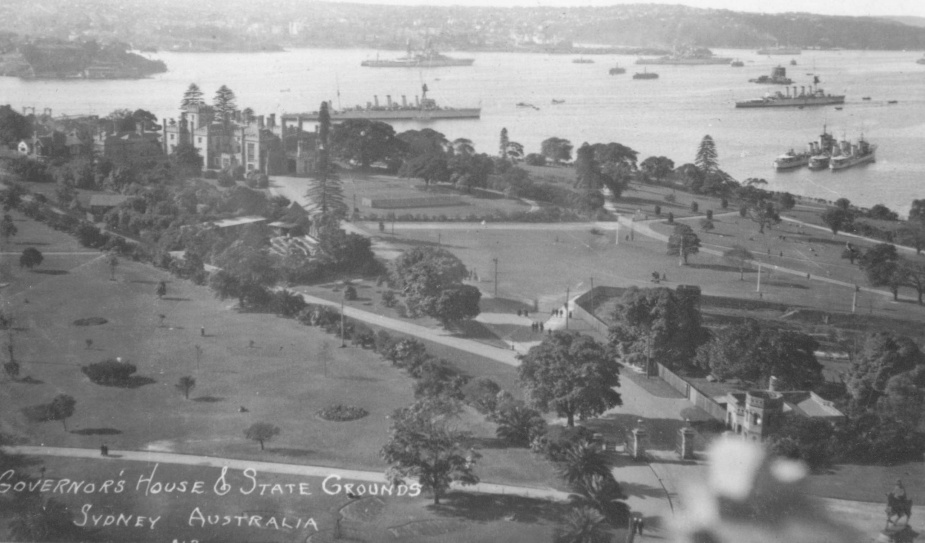The Decline of Australian Naval Deterrence 1919-1939
The Commonwealth Naval Forces inherited a motley collection of obsolescent coastal and harbour defence vessels when the State navies transferred to Commonwealth control on 1 March 1901. As a result, the defence of Australia’s sea lanes remained the responsibility of the Australian Squadron of the Royal Navy. On 24 November 1909 Prime Minister Joseph Cook received majority approval from the House of Representatives (by 39 votes to 9) for the scheme of Imperial naval defence espoused by Admiral Jackie Fisher, First Sea Lord of the British Admiralty, and immediate construction of an Australian fleet unit. The unit was to comprise an Indefatigable Class battlecruiser, three Bristol Class unarmoured cruisers, six River Class destroyers, and three C Class submarines. The cost to Australia was to be £3.695m - an astonishing figure for the newly federated nation of four million. Most importantly, unlike the Australian Squadron, the Australian fleet unit was to remain under the absolute control of the Commonwealth Government in peace and war, unless specifically placed under the control of the British Admiralty.
Australia’s drive to provide for its own naval defence, and contribute to Imperial naval defence, culminated on 4 October 1913 when the fleet unit, led by the battlecruiser HMAS Australia, proudly sailed into Sydney Harbour to the wild acclaim of the public. In just four years Australia had created a potent naval deterrent against any potential enemy raiding force. When the British Empire declared war on Germany and Austria-Hungary on 5 August 1914 the RAN mustered a battlecruiser, two new cruisers (with a third building), two older cruisers, three destroyers (with three building), two E Class submarines, and some old colonial warships.
This force far outmatched that of its local rival, the German East Asiatic Squadron commanded by Vice Admiral Graf Von Spee. In 1914 Australia was the most powerful warship in the entire southern hemisphere. Von Spee was well aware of the threat, stating in a letter to his wife that the battlecruiser ‘by itself, is an adversary so much stronger than our squadron that one would be bound to avoid it’. Von Spee did indeed avoid the Australian coast prior to the outbreak of war and, when faced with the potential threat of Japanese forces joining the conflict on the British side, sailed east into the Pacific. After the outbreak of war, In between searching for Von Spee, the RAN assisted in capturing the German colonies and wireless stations in the South Pacific, protecting ANZAC convoys, and sinking the cruiser SMS Emden. Von Spee did not return to the western Pacific, and on 8 December 1914 all but one of his ships were sunk off the Falklands. All significant threats in the Pacific having been destroyed, for the remainder of the war the major elements of the RAN patrolled the North Sea and Mediterranean alongside the Royal Navy.
By late 1919 the RAN’s strength had peaked at a battlecruiser, three cruisers (with one building), an older cruiser, six J Class submarines, twelve destroyers, four sloops, a gunboat, plus auxiliaries. However, despite the clear deterrent value that the RAN had provided against an enemy raiding threat, the ensuing fate of the RAN for the next two decades was far from happy. The jubilation that followed the arrival of the fleet unit in 1913 and the sinking of the Emden by HMAS Sydney in 1914 had been overshadowed by four years of bloody warfare. The feeling that the creation of a powerful navy had heralded the nation’s coming of age had been displaced by the growing ANZAC mythology, whereby the nation’s independence had been bought with blood on the shores of Gallipoli. While the Navy had grown to a strength of over 5000 personnel and 37 ships during WWI, this paled against the experience of the 421,809 men enlisted in the AIF and its 215,585 casualties (including 61,720 dead). The national psyche and sense of nationhood had firmly shifted from a naval to an army focus. This would have serious repercussions for the RAN from 1919-1939 in terms of trying to maintain a credible force, as the will to invest in an effective and independent navy declined.
Both victors and vanquished were crushed by the experience of 1914-18, and in its aftermath anti-war feelings ran high around the world. The League of Nations was created to prevent future conflict, by providing an international forum where countries could resolve their differences without recourse to war. Popular feeling in Australia and other Western nations was decidedly opposed to armaments and militarism, lest another ruinous war result. This feeling was compounded by the rise of socialist movements, notably unions, in the wake of the 1917 Russian Revolution, that saw standing military forces as potential tools to be used by the ruling elites to control the proletariat. As such, there was strong public and political pressure on successive Australian Governments to reduce military spending and divert that funding toward social benefit schemes.
Added to these problems, the Armed Forces in general, and the RAN in particular, faced increasing financial stringencies. The war had been ruinously expensive for the British Commonwealth. After expending £377m, the Australian Government ended the war with loans of £262.5m, including a debt to the United Kingdom of £43.4m, or 68% of GDP. Nor was this the full extent of the financial burden, for ongoing repatriation and pension expenses imposed a heavy and continuing drain on the post-war budget. By 1934 the total cost of the war had grown to £831.3m. The Great Depression would strike further blows at the RAN, resulting in the defence budget being slashed by 21% in 1930/31 and another 17% in 1931/32. At its lowest point in 1932 the RAN could muster only three ships in full commission, the heavy cruisers HMAS Australia and HMAS Canberra and the seaplane tender HMAS Albatross. The old destroyer HMAS Tattoo was in partial commission, and two light cruisers of 1908 design, HMAS Brisbane and HMAS Adelaide, were in reserve. Personnel numbers were cut to under 3000 and wages slashed by up to 25% to further save money.
The RAN also faced attack from the Army and RAAF, as each fought to retain its share of the depleted defence budget. The RAAF in particular pushed to replace the Navy as the first line of national defence, arguing that air power alone, through a combination of greater speed and mobility, could protect Australia’s local sea lines of communication and prevent invasion. This argument, which ignored the broader functions of the RAN including distant trade protection, power projection in the littoral, and providing a national presence, has been enduringly attractive to financially constrained Australian governments. While the air power argument was not fully accepted, successive governments seriously considered the idea of dispensing with the RAN and either distributing the task of naval defence to the Army and RAAF or returning it to the Royal Navy. Naval funding allocations suffered accordingly.
Doctrinally, the Royal Navy’s focus on trade protection had shifted from Fisher’s integrated units of battlecruisers and cruisers back to cruisers alone. The battlecruiser, originally intended to counter enemy cruisers in the same way as destroyers had been intended to counter torpedo boats, had been discredited by its failure at the Battle of Jutland to stand up to undamaged enemy battleships - a task for which it was not designed. Fisher, who had retired in 1915, was discredited, and the cruiser lobby, which had controlled the Admiralty prior to Fisher’s elevation to power, returned the Royal Navy to its original course. To fulfil the trade protection mission along the vast sea lanes of the Empire it was thought that many small cruisers were better than a few large battlecruisers. A battle fleet was still required for protection of home waters and the Mediterranean, plus the occasional foray into the Pacific, but battleships and carriers, not battlecruisers, would form its backbone. The doctrinal shift shaped the RAN, emphasising the need for cruisers to contribute to the protection of Imperial shipping, rather than a balanced fleet unit for national defence.
Following WWI Britain, America and Japan all instituted ambitious naval construction programs to introduce new designs reflecting wartime experience. America wished to achieve parity with the numerically superior Royal Navy, and restrict the Imperial Japanese Navy, without incurring the cost of a naval arms race. In 1921 President Harding called a conference between the USA, Britain, Japan, France and Italy to advocate mutual naval arms limitation. Faced with massive post-war debts all parties agreed on limitations. The ensuing 1922 Washington Five Power Naval Treaty made restrictive demands on the signatories. No new capital ships were to be built for 10 years and no capital ship was to be replaced until it was 20 years old. A capital ship ratio was set at 5:5:3:1.7:1.7, which assigned parity to Britain and America, placed Japan in third place, and left France and Italy bringing up the rear. Additional constraints were placed on tonnage and armament. There was also to be no expansion of existing bases, fortifications, or repair facilities in the Pacific - except Singapore. The immediate result of the treaty was that Britain, America and Japan scrapped a number of unfinished capital ships and older dreadnoughts. One of the ships included in the British tally, with the full concurrence of the Australian government, was the battlecruiser Australia. Henceforth Australian naval deterrence would be restricted to cruisers for local and Imperial trade protection.
As the depression eased, and faced by a worsening international situation the Australian Government looked again to the neglected RAN. In 1935 Japan had withdrawn from the Washington Treaty, Germany had repudiated the Treaty of Versailles, and both began building powerful navies. To provide a more useful trade protection force, the Government placed successive orders for three light cruisers, two destroyers and four sloops. Nonetheless, expenditure on the RAN continued to decline as a proportion of overall defence spending, reaching just 26% in 1939. When war was declared on 3 September 1939 the RAN had just two heavy cruisers, three modern light cruisers, a light cruiser of 1912 design, five WW1 vintage destroyers (with two new Tribal Class building) and two sloops (with two building).
Australian naval deterrence between the wars was a victim of an unfortunate series of circumstances, which saw the RAN reduced from a formidable fleet unit in 1919 to a limited trade protection force in 1939. This decline would have serious repercussions for Australia and the RAN when Japan thrust southward in 1942.




